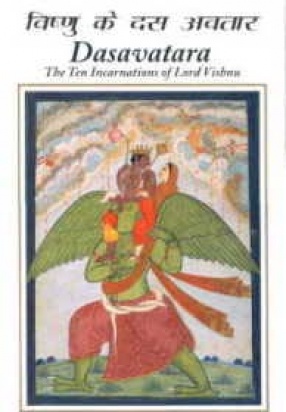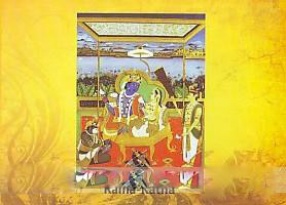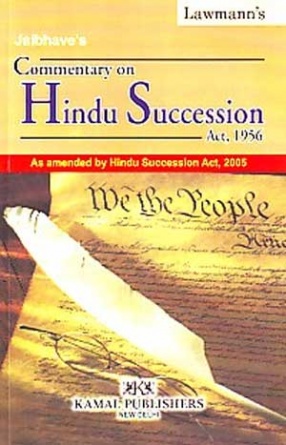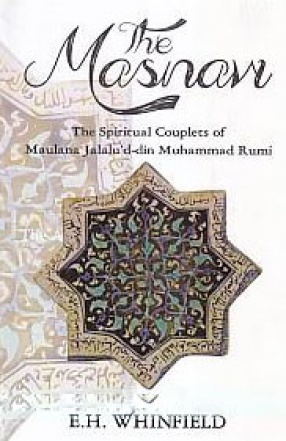Lord Vishnu one of the Trinity of Gods in the Hindu pantheon presides over the world as its creator, sustainer and destroyer. He manifests in his three faceted cosmic acts of creation, preservation and destruction, which in the Great Hindu Trinity is represented by Brahma, Vishnu and Shiva. Devotees of Vishnu are known as Vaishnavites and they consider Him the only God, who assumes the form of Brahma to create, Vishnu to preserve and Shiva to destroy. As creator he creates himself, as preserver he preserves himself and as destroyer he destroys himself at the end. The trinity is therefore part of the same Supreme Being and this philosophy of the Vaishnavites is known as Vaishnavism.
As a Vedic God, Vishnu finds mention in all the four Vedas the Rigveda, the Yajurveda, the Samaveda and the Atharvaveda. Vishnu's position in the Vedas is not one of great importance, but later he attains a very high position, especially in subsequent texts like the Puranas, which create an aura of glory and splendour and attribute a divine character to him.
Vishnu is usually depicted with four hands that carry four weapons. In one hand he holds the mace or Gada called Kaumodaki given to him by Varuna, the God of waters, that symbolizes intellect and the power of knowledge. He is hence sometimes called Kumodaka or one who delights the earth. In another hand he holds the charka or discus called Sudarshana, which symbolizes the cycles of life and death or Kala. The conch or Shanka called Panchajanya, which represents space as a manifestation of sound and the Padma or lotus symbolic of the universe, creation and fertility are in his other hands. Vishnu's consort is Lakshmi or Sri, the Goddess of riches and fertility and Brahma his son by imagination. His vehicle or vahana is Garuda-the Great Eagle.
Lord Vishnu presides over the universe as its sustainer and benefactor. He is believed to incarnate as often as required for eliminating the forces of evil and re-establishing righteousness. The word avatara has its root in Sanskrit, implying the descent of God and is used in the Hindu context mainly for Vishnu's incarnations. In Hindu philosophy the concept of the avataras finds a very significant place and forms the very essence of the Vaishnavite tradition. He is the only one who has the power to incarnate in three forms-as Purnavatara or complete incarnation, as Anshaavatara or partial incarnation or as Avesavatara or the partial incarnation of a temporary nature.
The Mahavataras or great incarnations of Vishnu are generally known as the Dasavatara, the ten incarnations of Vishnu. Of these nine have already manifested and one is yet to come. The ten are:
Matsyavatara: as a fish, who saved Manu from the great Deluge and rescued the Vedas. It symbolizes the restoration of true knowledge, which had been subverted by the ego and destroyed in the process.
Kurmavatara: as a tortoise, who held Mount Mandara on his back while the Gods and demons churned the ocean for Amrita or the nectar of immortality.
Varahavatara: as a boar, rescuing the earth from the waters in which it had been submerged. This avatara is associated with sacrifice.
Narasimhavatara: as a man-lion, to liberate the world from the demon Hinanyakasipu, who had a boon of invincibility from Brahma that he could not be slain by God or man or animal. This avatara is symbolic of devotion.
Vamanavatara: as a dwarf begging for only three steps of land, but covers in his three strides the three worlds or lokas. This is symbolic of the crushing of the ego and that valor can only find fulfillment when we surrender completely to God.
Parshuramavatara: as a hero with an axe or Parshu, destroying the ego of the Kshatriyas or warrior class.
Ramavatara: a perfect man who destroys Ravana and many other demons.
Krishnavatara: the complete one or Puranavatara the perfect incarnation of Vishnu.
Buddhavatara: the enlightened one or Balaramavatara: the elder brother of Krishna.
Kalki-Avatara: This avatara is yet to come and will destroy the wicked, restoring peace and order on earth.








There are no reviews yet.